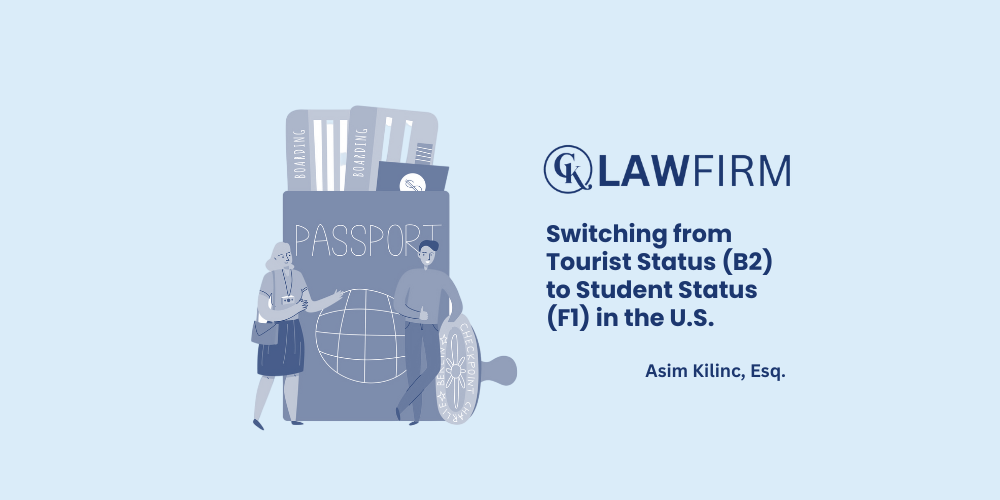Schedule an Appointment with Our Attorneys Now

Switching from Tourist Status (B2) to Student Status (F1) in the U.S.
By Asim Kilinc, Immigration Attorney at CK Law Firm
Many individuals who enter the U.S. as tourists may later consider switching to student status to pursue education. This can be an attractive option for those looking to take advantage of educational opportunities and build a career in America. However, the process of changing from a B2 tourist visa to an F1 student visa is governed by strict rules and requires careful planning. In this article, we will cover the details of the transition from tourist to student status within the U.S. and the steps you need to follow:
- Key Differences Between the B2 Tourist Visa and the F1 Student Visa
- Intent Issues: Things to Keep in Mind if You Plan to Study When Entering the U.S.
- Requirements for Status Change
- The Application Process for Status Change
- What to Do After Your Application is Approved
- What to Do if Your Application is Denied
For additional questions, feel free to reach out through the comments section of this article, send me a message directly on LinkedIn, or contact me via the CK Law Firm Immigration Law Firm website, which I co-founded.
Key Differences Between the B2 Tourist Visa and the F1 Student Visa
The B2 visa allows you to enter the U.S. as a tourist. It is typically used for tourism, medical treatment, or short-term visits. However, the B2 visa does not permit you to work or study in the U.S. If you decide to pursue education, you will need to switch to an F1 student visa.
The F1 visa is required for individuals planning to undertake full-time studies in the U.S. It allows you to attend universities, colleges, language schools, or other academic institutions. The F1 visa can be obtained either by applying at a U.S. consulate outside the country or through a change of status within the U.S. This article will focus on the latter.
Intent Issues: Things to Keep in Mind if You Plan to Study When Entering the U.S.
When entering the U.S. on a B2 visa, your intent must be for tourism. Immigration authorities may deny your request if they suspect you entered the U.S. with the primary intention of studying.
It’s essential to prove that you had no intention of studying at the time of your entry. Applying for an F1 visa immediately after entering the U.S. could lead authorities to believe that your actual intent was education rather than tourism. Therefore, it is generally recommended to wait at least 90 days after entering the U.S. before applying for a change to F1 status.
Requirements for Status Change
To switch from a B2 tourist visa to an F1 student visa within the U.S., you must meet certain criteria:
- Hold a valid B2 visa: You must have legally entered the U.S. with a B2 visa that has not expired.
- Declare your intent to study: To change to F1 status, you must provide proof of enrollment in a full-time academic program.
- Prove financial resources: Studying and living in the U.S. can be expensive, so you must demonstrate sufficient financial resources to cover your tuition and living expenses. Bank statements or sponsor letters are critical at this stage.
- Apply within the legal time frame: You must submit your application before your B2 visa expires. Failure to do so may result in denial of your application and unlawful presence in the U.S.
Application Process for Status Change
To change your status from a B2 tourist visa to an F1 student visa within the U.S., follow these steps:
a. Enroll in a U.S. Educational Institution and Obtain the I-20 Form
The first step is to be accepted by a U.S. educational institution. Once accepted, the school will issue an I-20 form. This document confirms that you are enrolled as a full-time student and can meet the financial requirements for your studies.
b. Fill Out and Submit Form I-539
To apply for a status change, you must complete and submit Form I-539. This can be done online or by mail through USCIS (U.S. Citizenship and Immigration Services).
Along with Form I-539, you must submit the following documents:
- The I-20 Form: Provided by your educational institution.
- Financial proof: Bank statements or sponsor documents demonstrating your ability to cover educational and living expenses.
- A copy of your passport and current B2 visa.
- Acceptance letter: The official acceptance letter from your school.
- Application fee: Payment for the application process.
c. Processing Time
It may take several months for USCIS to process your change of status application. During this period, your B2 tourist status must remain valid. You cannot start your education until your F1 status is approved.
USCIS may request additional documentation or schedule an interview. Submitting complete and accurate information will improve your chances of approval.
What to Do After Your Application is Approved
Once approved, you may begin your studies as an F1 student. The F1 visa allows you to study full-time in the U.S. but comes with certain restrictions:
- Part-time employment: F1 visa holders can generally work up to 20 hours per week on campus. Special permits are required for off-campus work (such as CPT or OPT).
- Visa renewal: You can maintain F1 status until your academic program ends. After completion, you must either leave the U.S. or apply for another visa status.
What to Do if Your Application is Denied
If your application is denied, USCIS will inform you of the reasons for denial. At this point, you have several options:
- Leave the U.S.: You must leave the country before your B2 visa expires to avoid unlawful presence.
- Apply for an F1 visa abroad: After leaving the U.S., you may apply for an F1 visa at a U.S. consulate in your home country.
- Appeal the decision: You may have the right to appeal and request a reconsideration. However, this process can be complex, and professional legal assistance may be necessary.
Conclusion
Changing from tourist to student status in the U.S. is possible with careful planning and the correct documentation. Following USCIS rules, submitting a complete application, and providing necessary documents are critical. Each case is unique, so working with an experienced immigration attorney can increase the chances of success. At CK Law Firm, we provide professional support for B2 to F1 status changes and other immigration matters, helping you start your education journey in the U.S. with confidence. For more information, feel free to contact us at cklawfirm.org, via email at info@cklawfirm.org, or through LinkedIn.
Who is Attorney Asım Kılınç?
Attorney Asım Kılınç is the co-founder of CK Law Firm and is recognized for his expertise in immigration law and U.S. asylum applications. Kılınç completed his Master’s degree at Southern Methodist University Dedman School of Law and is a member of the Missouri Bar Association, with a focus on U.S. immigration law.
Attorney Kılınç’s extensive knowledge and experience in immigration law have significantly contributed to CK Law Firm’s success in this field. He has actively participated in the preparation of over 1,000 cases, demonstrating his expertise in this area. By providing comprehensive and professional legal support to his clients, he helps them adapt to their new lives in the U.S.
Attorney Kılınç is also well-versed in U.S. asylum applications. He meticulously guides his clients through the process and ensures they receive the best legal advice. He provides top-quality service to clients in matters of citizenship, Green Card, work permits, and other immigration processes, supporting them from start to finish on their journey to U.S. citizenship.
Attorney Asım Kılınç, who solidifies CK Law Firm’s leadership in immigration law and U.S. asylum applications, offers reliable and effective legal consultancy services to clients, assisting them in building a new life in the U.S.





